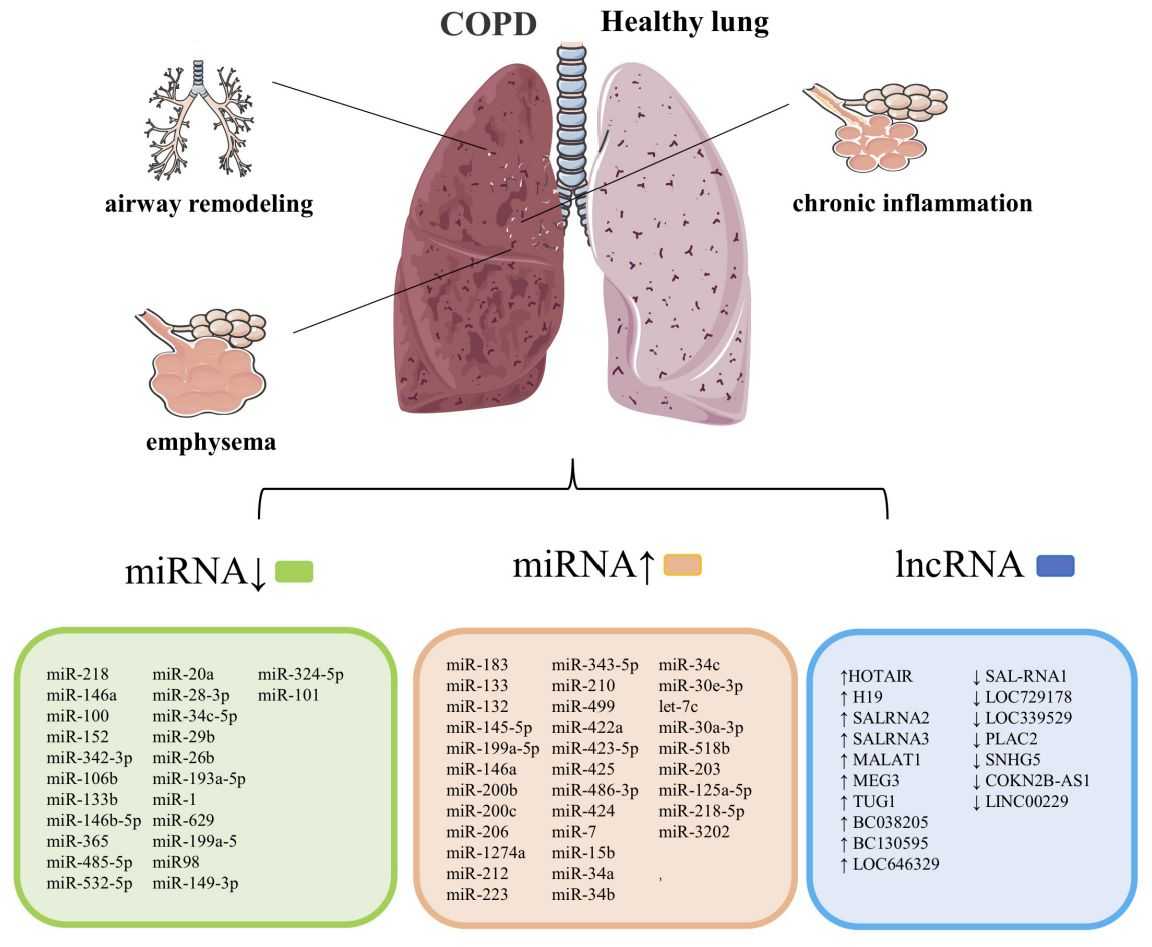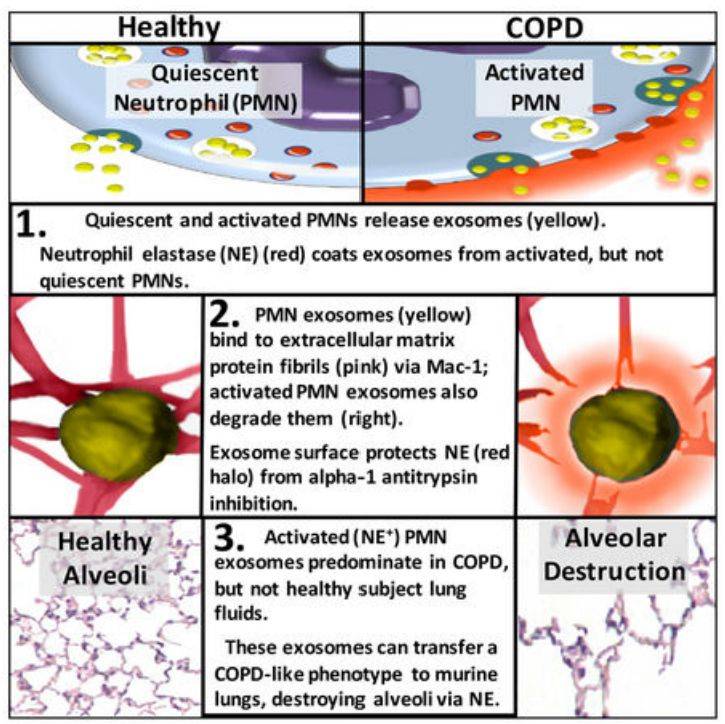Exosome Research in Human Chronic Obstructive Pulmonary Disease
Chronic obstructive pulmonary disease (COPD) is a common respiratory disease. Inflammation, protease-antiprotease imbalance, oxidative stress, autonomic dysfunction, and other pathogenic mechanisms may be involved in the development of COPD. Numerous studies have shown that exosomes play an important role in developing COPD, and have promising applications in the pathogenesis, diagnosis, and treatment of COPD.
Exosomes and COPD
COPD is a chronic inflammatory disease of the airways, mainly due to the persistent chronic inflammatory response leading to the destruction of the alveolar walls and thinning of the alveolar sacs, which in turn causes dyspnea and reduced lung function. Exosomes are increasingly recognized as important carriers of circulating biological markers for intercellular communication, immune regulation, disease diagnosis, and prognosis. Exosomes play an important role in the development and progression of COPD. By carrying specific miRNAs and proteins, exosomes can regulate gene expression in target cells, affecting pathological processes such as airway inflammation and fibrosis.
 Figure 1. The role of exosomes in the development and progression of COPD. (Wang N, et al., 2021)
Figure 1. The role of exosomes in the development and progression of COPD. (Wang N, et al., 2021)
- Exosomes as COPD Diagnostic Markers
Several studies have shown that the exosomal miRNA profile of COPD patients is significantly different from that of healthy individuals. Exosomal miRNAs, such as miRNA-21, let-7, etc., have significantly changed expression levels in the blood, sputum, and other body fluids of COPD patients, suggesting that these miRNAs are expected to be non-invasive diagnostic biomarkers for COPD. By detecting the expression levels of these miRNAs, early diagnosis and disease monitoring of COPD can be realized.
- Exosomes as Therapeutic Targets in COPD
Given the important role of exosomes in the pathogenesis of COPD, interventions targeting exosomes and the miRNAs and proteins they carry are expected to be a new strategy for COPD treatment. For example, by inhibiting the expression of certain pro-inflammatory miRNAs in exosomes, airway inflammatory responses can be attenuated. By promoting the release of certain anti-inflammatory and reparative molecules in exosomes, it can promote the repair and regeneration of lung tissues. In addition, utilizing exosomes as drug carriers to deliver specific therapeutic drugs or genes to target cells is one of the hotspots of current research.
| Cat No. | Product Name | Source |
| Exo-HDBF-07 | HQExo™ Exosome-SDH-Chronic Obstructive Pulmonary Disease plasma | Exosome derived from Single Donor Human Chronic Obstructive Pulmonary Disease plasma |
| Explore All Exosomes Isolated from Human Chronic Obstructive Pulmonary Disease Plasma | ||
Research Cases
- Activated Polymorphonuclear Leukocyte-Derived Exosomes Cause COPD
Studies have shown that neutrophil elastase (NE) resists the enzymatic action of α1-antitrypsin (α1AT), which ruptures the extracellular matrix (ECM) and exacerbates lung parenchymal deformation. The researchers found that activated polymorphonuclear leukocytes (PMN) contain more NE on the surface of exosomes secreted by PMN compared to quiescent PMN by proteomics techniques. Animal experiments proved that Act exo can cause emphysema in healthy mice. Finally, exosomes in alveolar lavage fluid (BALF) are isolated by ultracentrifugation, and it is found that BALF exosomes from COPD patients contained more active PMN cell surface markers (CD63 and CD66b) compared to healthy controls. Animal studies demonstrated that patient BALF exosomes can lead to COPD-like symptoms in mice.
 Figure 2. Activated PMN exosomes lead to the destruction of the lung stroma. (Genschmer KR, et al., 2019)
Figure 2. Activated PMN exosomes lead to the destruction of the lung stroma. (Genschmer KR, et al., 2019)
- Plasma Exosomal miRNA as a Biomarker for COPD
First, the investigators isolate plasma exosomes using kits. Differentially expressed miRNAs are identified by exosomal RNA-Seq from non-smokers, smokers, and COPD, respectively. There are 40 significantly differentially expressed miRNAs in the non-smokers group compared with COPD, and 40 significantly differentially expressed miRNAs in the smokers group compared with COPD. The results suggest that exosomal miRNA-based molecular analysis has great potential for use in the development of biomarkers for the diagnosis, prognosis, and treatment of COPD.
 Figure 3. Identification of novel exosomal miRNA biomarkers for COPD by RNA sequencing and qPCR validation. (Sundar IK, et al., 2019)
Figure 3. Identification of novel exosomal miRNA biomarkers for COPD by RNA sequencing and qPCR validation. (Sundar IK, et al., 2019)
Exosomes play an important role in the pathogenesis and development of lung diseases. By isolating and characterizing exosomes from multiple sources, Creative Biostructure can delve deeper into the pathogenesis of lung diseases and develop new therapeutic approaches, bringing more opportunities and hope for the treatment of COPD. If you are interested in our business or have any doubts, please feel free to contact us for more details.
References
- Wang N, et al. The Potential Roles of Exosomes in Chronic Obstructive Pulmonary Disease. Front Med (Lausanne). 2021. 7: 618506.
- Genschmer KR, et al. Activated PMN Exosomes: Pathogenic Entities Causing Matrix Destruction and Disease in the Lung. Cell. 2019. 176(1-2): 113-126.e15.
- Sundar IK, et al. Small RNA-sequence analysis of plasma-derived extracellular vesicle miRNAs in smokers and patients with chronic obstructive pulmonary disease as circulating biomarkers. J Extracell Vesicles. 2019. 8(1): 1684816.